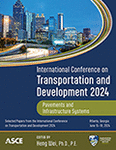Forecasting Highway Maintenance Cost at the Early Stage Using Machine Learning
Publication: International Conference on Transportation and Development 2024
ABSTRACT
Accurate cost estimation has been a notable challenge for developing cost-effective highway maintenance plans. While multiple variables, including market indices, have been used to attain higher accuracy of cost estimation models, the difficulty escalates for long-term forecasting. Especially in the prediction of early-stage projects, the limited amount of information and the unpredictability of market conditions make it intricate to achieve the desired accuracy. This paper applies machine learning (ML) to develop a highway maintenance cost forecasting model using only the early-stage project details. Georgia Department of Transportation (GDOT) pavement data from 2017 to 2021, consisting of “bidding-related,” “asset-related,” and “project-related” variables, is input to ML methods including linear regression, random forest, extra trees, gradient descent, extreme gradient descent, and k-nearest neighbors. Extra trees regression showed the lowest mean absolute percentage error of 18.51% after fivefold cross-validation. This study will work as a reference for DOTs to implement ML in the long-term maintenance cost prediction and ultimately be utilized in the tradeoff analysis of optimal management strategies.
Get full access to this chapter
View all available purchase options and get full access to this chapter.
REFERENCES
Ahmad, M. W., J. Reynolds, and Y. Rezgui. (2018). “Predictive modelling for solar thermal energy systems: A comparison of support vector regression, random forest, extra trees and regression trees.” J Clean Prod, 203: 810–821. Elsevier Ltd. https://doi.org/10.1016/j.jclepro.2018.08.207.
Allen, B. W., K. A. Zimmerman, G. M. Duncan, R. Zilay, and J. Holabaugh. (2023). A Guide to Incorporating Maintenance Costs into a Transportation Asset Management Plan. Washington, D.C.: Transportation Research Board.
Alsharef, A., S. Banerjee, S. M. J. Uddin, A. Albert, and E. Jaselskis. (2021). “Early impacts of the COVID-19 pandemic on the United States construction industry.” Int J Environ Res Public Health, 18 (4): 1–21. MDPI AG. https://doi.org/10.3390/ijerph18041559.
Assaad, R., and I. H. El-Adaway. (2021). “Guidelines for Responding to COVID-19 Pandemic: Best Practices, Impacts, and Future Research Directions.” https://doi.org/10.1061/(ASCE).
Bock, M., A. Cardazzi, and B. R. Humphreys. (2021). Where the Rubber Meets the Road: Pavement Damage Reduces Traffic Safety and Speed.
Breiman, L. (2001). Random Forests.
Budget Office, C. (2023) Chad Shirley, Principal Analyst Microeconomic Studies Division The Status of the Highway.
Cao, Y., and B. Ashuri. (2020). “Predicting the Volatility of Highway Construction Cost Index Using Long Short-Term Memory.” Journal of Management in Engineering, 36 (4). American Society of Civil Engineers (ASCE). https://doi.org/10.1061/(asce)me.1943-5479.0000784.
Cao, Y., B. Ashuri, and M. Baek. (2018). “Prediction of Unit Price Bids of Resurfacing Highway Projects through Ensemble Machine Learning.” Journal of Computing in Civil Engineering, 32 (5). American Society of Civil Engineers (ASCE). https://doi.org/10.1061/(asce)cp.1943-5487.0000788.
Chen, T., and T. He. (2023). xgboost: eXtreme Gradient Boosting.
Friedman, J. H. (2001). Greedy Function Approximation: A Gradient Boosting Machine.
Geurts, P., D. Ernst, and L. Wehenkel. (2006). “Extremely randomized trees.” Mach Learn, 63 (1): 3–42. https://doi.org/10.1007/s10994-006-6226-1.
“How construction can emerge stronger after coronavirus | McKinsey.” (2020). Accessed March 24, 2023. https://www.mckinsey.com/capabilities/operations/our-insights/how-construction-can-emerge-stronger-after-coronavirus#/.
Ilbeigi, M., B. Ashuri, and A. Joukar. (2017). “Time-Series Analysis for Forecasting Asphalt-Cement Price.” Journal of Management in Engineering, 33 (1). American Society of Civil Engineers (ASCE). https://doi.org/10.1061/(asce)me.1943-5479.0000477.
Kraskov, A., H. Stögbauer, and P. Grassberger. (2004). “Estimating mutual information.” Phys Rev E Stat Phys Plasmas Fluids Relat Interdiscip Topics, 69 (6): 16. https://doi.org/10.1103/PhysRevE.69.066138.
Li, M., and B. Ashuri. (2021). “Proportional Cox Hazards Model to Quantify the Likelihood of Underestimation in Transportation Projects.” J Constr Eng Manag, 147 (10). American Society of Civil Engineers (ASCE). https://doi.org/10.1061/(asce)co.1943-7862.0002164.
Li, M., M. Baek, and B. Ashuri. (2021). “Forecasting Ratio of Low Bid to Owner’s Estimate for Highway Construction.” J Constr Eng Manag, 147 (1). American Society of Civil Engineers (ASCE). https://doi.org/10.1061/(asce)co.1943-7862.0001970.
Nasteski, V. (2017). “An overview of the supervised machine learning methods.” HORIZONS.B, 4: 51–62. University St. Kliment Ohridski - Bitola. https://doi.org/10.20544/horizons.b.04.1.17.p05.
Rodríguez, J. D., A. Pérez, and J. A. Lozano. (2010). “Sensitivity Analysis of k-Fold Cross Validation in Prediction Error Estimation.” IEEE Trans Pattern Anal Mach Intell, 32 (3): 569–575. https://doi.org/10.1109/TPAMI.2009.187.
Santero, N. J., and A. Horvath. (2009). “Global warming potential of pavements.” Environmental Research Letters, 4 (3). Institute of Physics Publishing. https://doi.org/10.1088/1748-9326/4/3/034011.
Anderson, S., K. Molenaar, and C. Schexnayder. (2006). “THE NATIONAL ACADEMIES PRESS Final Report for NCHRP Report 574: Guidance for Cost Estimation and Management for Highway Projects During Planning, Programming, and Preconstruction.”. https://doi.org/10.17226/22045.
Wang, T., J. Harvey, J. Lea, and C. Kim. (2014). “Impact of pavement roughness on vehicle free-flow speed.” J Transp Eng, 140 (9). American Society of Civil Engineers (ASCE). https://doi.org/10.1061/(ASCE)TE.1943-5436.0000689.
Wilmot, C., and B. Mei. (2005). “Neural Network Modeling of Highway Construction Costs.” https://doi.org/10.1061/ASCE0733-93642005131:7765.
Zhang, Y., R. Edward Minchin, and D. Agdas. (2017). “Forecasting Completed Cost of Highway Construction Projects Using LASSO Regularized Regression.” https://doi.org/10.1061/(ASCE)CO.1943.
Information & Authors
Information
Published In
History
Published online: Jun 13, 2024
Authors
Metrics & Citations
Metrics
Citations
Download citation
If you have the appropriate software installed, you can download article citation data to the citation manager of your choice. Simply select your manager software from the list below and click Download.
